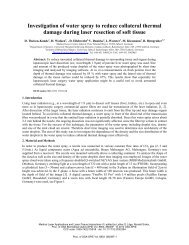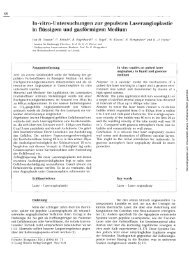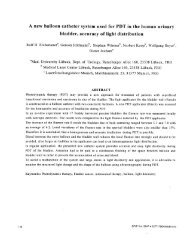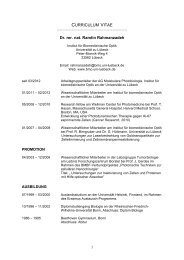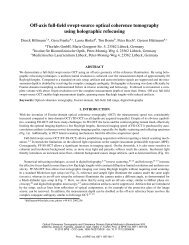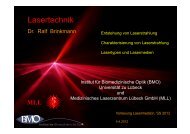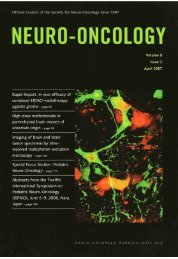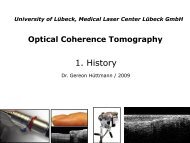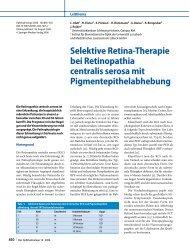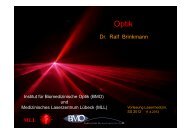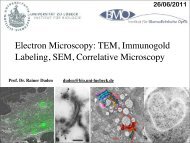Invited p aper Mechanisms of femtosecond laser nanosurgery of ...
Invited p aper Mechanisms of femtosecond laser nanosurgery of ...
Invited p aper Mechanisms of femtosecond laser nanosurgery of ...
You also want an ePaper? Increase the reach of your titles
YUMPU automatically turns print PDFs into web optimized ePapers that Google loves.
1028 Applied Physics B – Lasers and OpticsFIGURE 10 Temperature evolution at the center <strong>of</strong> the <strong>laser</strong> focus producedby a series <strong>of</strong> 800-nm, 100-fs pulses focused into water. (a) 80-MHz repetitionrate, NA = 1.3; (b) 80-MHz repetition rate, NA = 0.6; (c) 1-MHzrepetition rate, NA = 0.6. The volumetric energy density deposited per pulseis always 1 J cm −3 at the focus center. The dashed lines represent thetemperature decay after a single pulse. For comparison, the temperature evolutionduring cw irradiation with the same average power as for the pulsedirradiation is also showndiameter <strong>of</strong> the initial temperature distribution (1/e 2 values)amounts to 336 nm and the length to 806 nm (Sect. 3.2). Figure10 shows the calculated temperature evolution at the center<strong>of</strong> the <strong>laser</strong> focus when series <strong>of</strong> 800-nm, 100-fs pulses arefocused into water at different repetition rates (80 MHz and1MHz) and numerical <strong>aper</strong>tures (NA = 1.3 and NA = 0.6).It was assumed that with each pulse an energy density <strong>of</strong>1Jcm −3 at the center <strong>of</strong> the initial temperature distribution isdeposited. For other values <strong>of</strong> the volumetric energy density,the shape <strong>of</strong> the temperature vs time curve will be the samebut the absolute value <strong>of</strong> the temperature varies proportionallyto the peak density <strong>of</strong> absorbed power, A. For comparison,we also calculated the temperature evolution during cw irradiationwith the same average power as for the pulsed irradiation(dotted lines in Fig. 10a–c). For 80-MHz repetition rate,pulsed and continuous energy deposition differ significantlyonly during the first 100 ns.The calculations in Fig. 10a for tightly focused irradiationwith 80-MHz repetition rate reveal that the temperature is only6.8 times larger after a few microseconds than the temperatureincrease caused by a single pulse. This implies that onlya moderate heat accumulation occurs during plasma-mediatedcell surgery. However, when the numerical <strong>aper</strong>ture is reducedfrom NA = 1.3 to NA = 0.6, such as in Fig. 10b, a 45-foldtemperature increase is predicted. Temperature accumulationcan almost entirely be avoided if, at the same NA, the repetitionrate is lowered to 1MHz(Fig. 10c). In this case, thepeak temperature in a long pulse series is only 1.36 timeslarger than after a single pulse. For 1-MHz repetition rate andNA = 1.3, this factor reduces to 1.024.When <strong>laser</strong> surgery is performed with 80-MHz pulse seriesfocused at NA = 1.3, the boiling temperature <strong>of</strong> 100 ◦ Cwill, due to the 6.8-fold temperature accumulation, be reachedwhen each individual pulse produces a temperature rise <strong>of</strong>11.8 ◦ C (starting from 20 ◦ C room temperature). For 800-nm,100-fs pulses this temperature rise requires a free-electrondensity <strong>of</strong> ϱ c = 2.1 × 10 19 cm −3 , which is reached at an irradiance<strong>of</strong> 0.51 times the value required for optical breakdown(ϱ cr = 10 21 cm −3 ).The temperature distribution in the vicinity <strong>of</strong> the <strong>laser</strong> focusduring application <strong>of</strong> 80-MHz pulse series is presentedin Fig. 11 for different numerical <strong>aper</strong>tures. The distributionarising from the ellipsoidal focus volume is plotted both inradial and axial directions. For NA = 1.3, the temperaturedistribution remains fairly narrow (FWHM ≈ 600 nm) evenafter a few milliseconds when a dynamic equilibrium betweenenergy deposition and heat diffusion has been established.The rapid decrease <strong>of</strong> the temperature with increasing distancefrom the <strong>laser</strong> focus is related to the small size <strong>of</strong> thefocal volume, which allows for rapid heat diffusion in all directions.By contrast, for NA = 0.6 the steady-state temperaturedistribution is more broadened compared to the singlepulsedistribution, in addition to the stronger increase <strong>of</strong> thepeak temperature. Both temperature accumulation and broadening<strong>of</strong> the temperature distribution can be avoided withrepetition rates ≤ 1MHz.At first sight, the results <strong>of</strong> our temperature calculationsmight suggest that an irradiance range below the opticalbreakdown threshold exists where predominantly thermal effectsin biological media can be produced. However, oneneeds to consider that about 10 6 free electrons per pulse aregenerated in the focal volume at the irradiance that createsa temperature difference <strong>of</strong> 11.8 ◦ C per pulse and a peak temperature<strong>of</strong> 100 ◦ C after a pulse series <strong>of</strong> several microseconds(for NA = 1.3). Any thermal denaturation <strong>of</strong> biomoleculeswill thus always be mixed with free-electron-induced chemicaleffects, and the latter will probably dominate.5.3 Comparison with cw irradiation <strong>of</strong> linear absorbersSince various researchers have produced cellularmicroeffects using long-pulsed or continuous-wave irradiation[47, 52, 56, 69–71], it is <strong>of</strong> interest to compare thewidths <strong>of</strong> the temperature distributions produced by series <strong>of</strong>ultra-short <strong>laser</strong> pulses and cw irradiation.Figure 12 shows the evolution <strong>of</strong> the temperature distributionwhen cw irradiation <strong>of</strong> 514-nm wavelength is fo-



